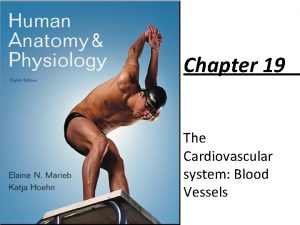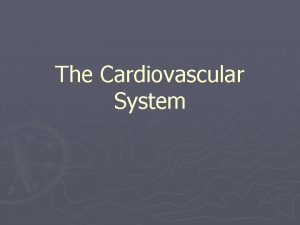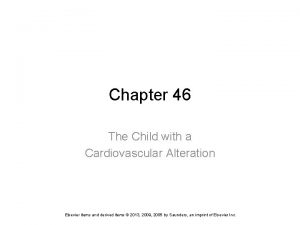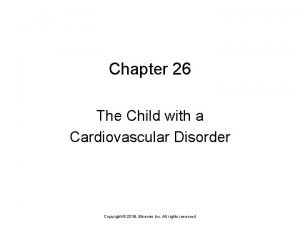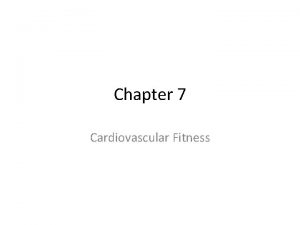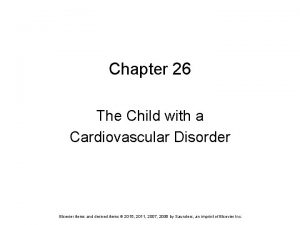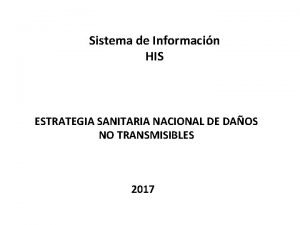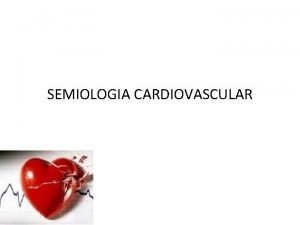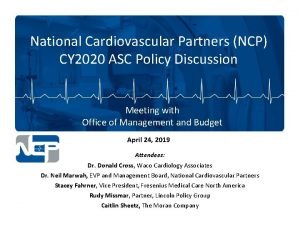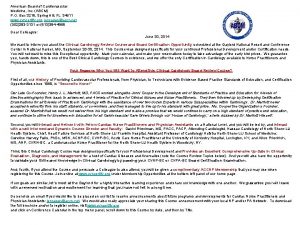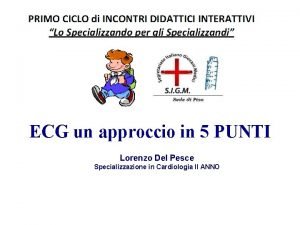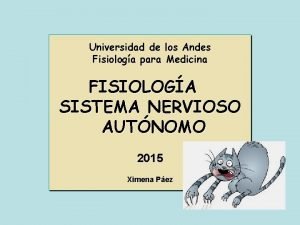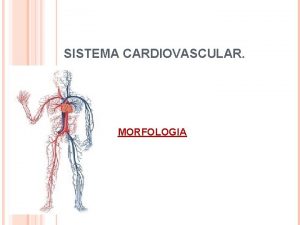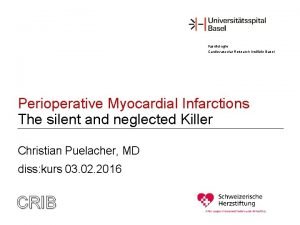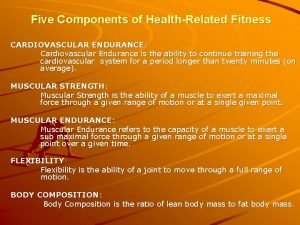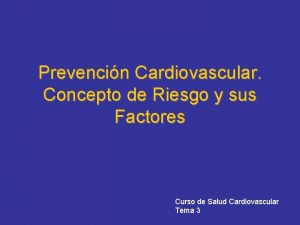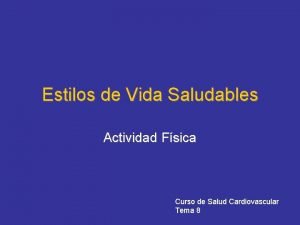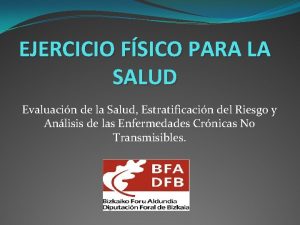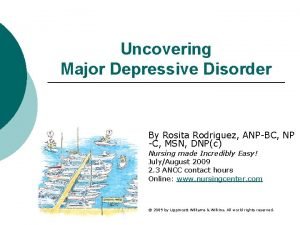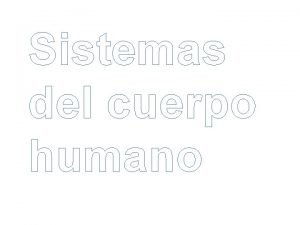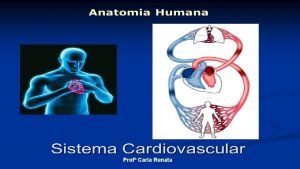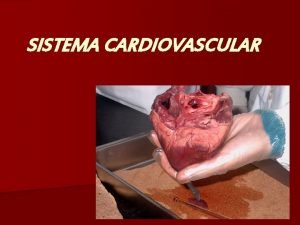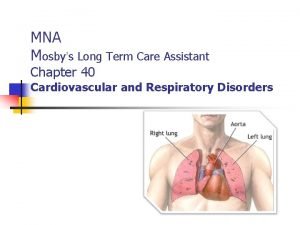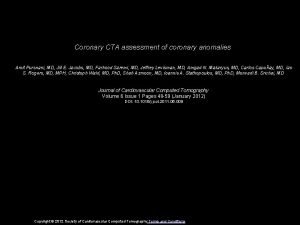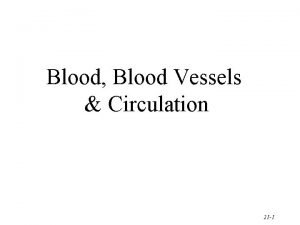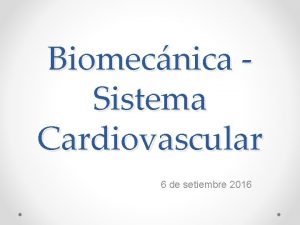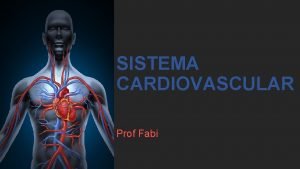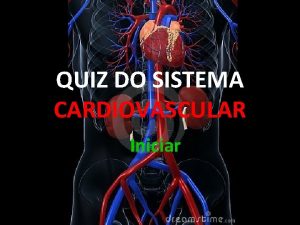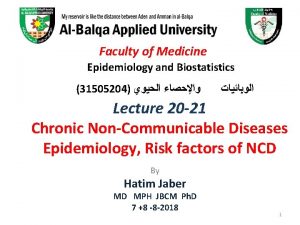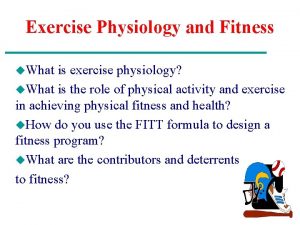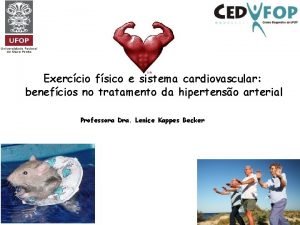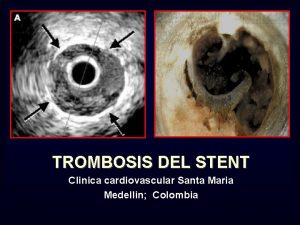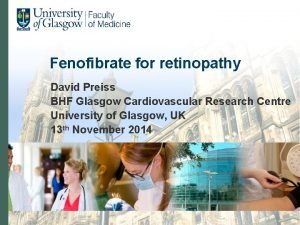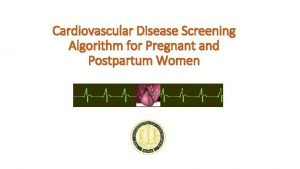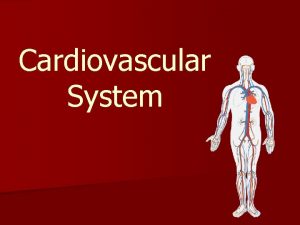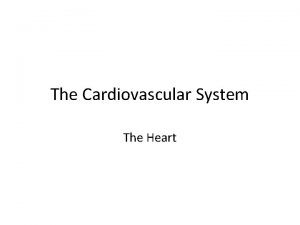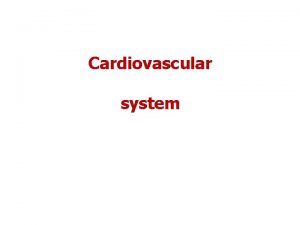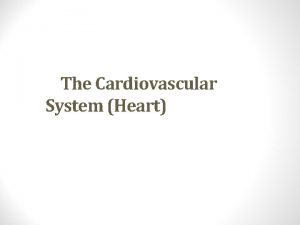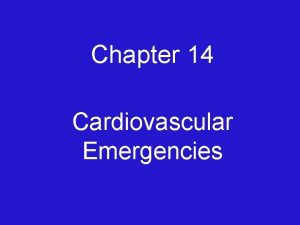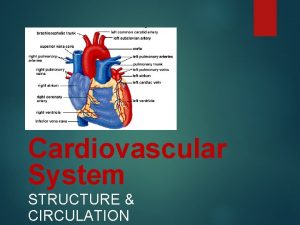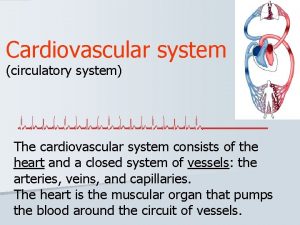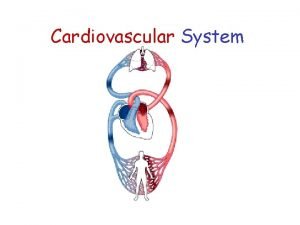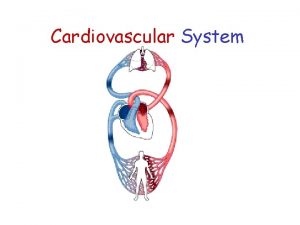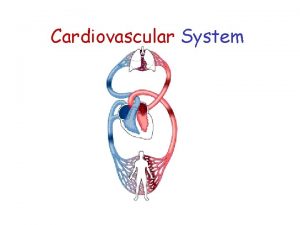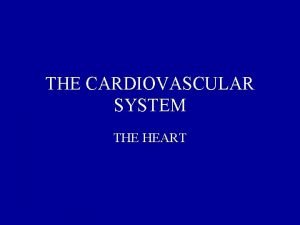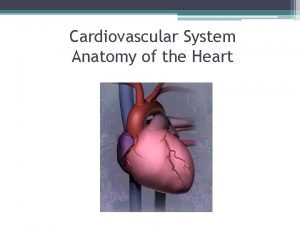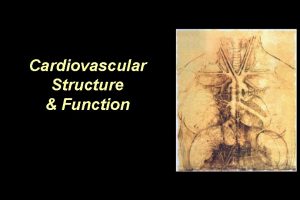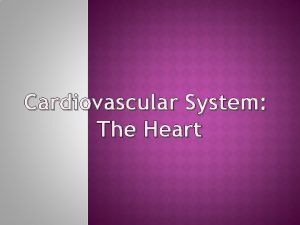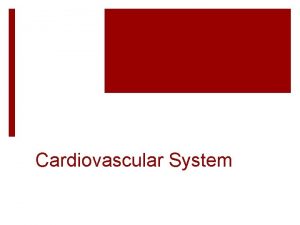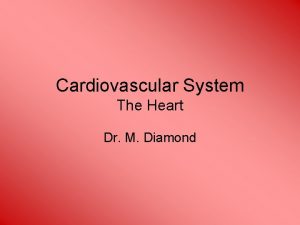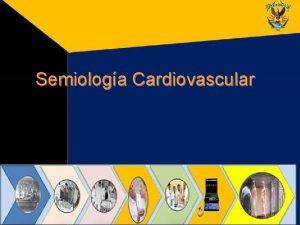Chapter 18 The Cardiovascular System The Heart Heart
















































































- Slides: 80

Chapter 18 The Cardiovascular System: The Heart

Heart Anatomy • Approximately the size of a fist • Location –In the mediastinum between second rib and fifth intercostal space –On the superior surface of diaphragm –Two-thirds to the left of the midsternal line –Anterior to the vertebral column, posterior to the sternum • Enclosed in pericardium, a double-walled sac

Midsternal line 2 nd rib Sternum Diaphragm (a) Point of maximal intensity (PMI) Figure 18. 1 a

Superior vena cava Aorta Parietal pleura (cut) Pulmonary trunk Left lung Pericardium (cut) Diaphragm Apex of heart (c) Figure 18. 1 c

Pericardium • Superficial fibrous pericardium • Protects, anchors, and prevents overfilling • Deep two-layered serous pericardium –Parietal layer lines the internal surface of the fibrous pericardium –Visceral layer (epicardium) on external surface of the heart –Separated by fluid-filled pericardial cavity (decreases friction)

Pulmonary trunk Pericardium Myocardium Fibrous pericardium Parietal layer of serous pericardium Pericardial cavity Epicardium (visceral layer Heart of serous wall pericardium) Myocardium Endocardium Heart chamber Figure 18. 2

Layers of the Heart Wall 1. Epicardium—visceral layer of the serous pericardium 1. Myocardium—Spiral bundles of cardiac muscle cells 3. Endocardium is continuous with endothelial lining of blood vessels

Pulmonary trunk Pericardium Myocardium Fibrous pericardium Parietal layer of serous pericardium Pericardial cavity Epicardium (visceral layer Heart of serous wall pericardium) Myocardium Endocardium Heart chamber Figure 18. 2

Cardiac muscle bundles Figure 18. 3

Chambers • Four chambers Two atria • Separated internally by the interatrial septum • Coronary sulcus (atrioventricular groove) encircles the junction of the atria and ventricles • Auricles increase atrial volume Two ventricles • Separated by the interventricular septum • Anterior and posterior interventricular sulci mark the position of the septum externally

Brachiocephalic trunk Superior vena cava Right pulmonary artery Ascending aorta Pulmonary trunk Right pulmonary veins Right atrium Right coronary artery (in coronary sulcus) Anterior cardiac vein Right ventricle Right marginal artery Small cardiac vein Inferior vena cava (b) Anterior view Left common carotid artery Left subclavian artery Aortic arch Ligamentum arteriosum Left pulmonary artery Left pulmonary veins Auricle of left atrium Circumflex artery Left coronary artery (in coronary sulcus) Left ventricle Great cardiac vein Anterior interventricular artery (in anterior interventricular sulcus) Apex Figure 18. 4 b

Atria: The Receiving Chambers • Walls are ridged by pectinate muscles • Vessels entering right atrium –Superior vena cava –Inferior vena cava –Coronary sinus • Vessels entering left atrium –Right and left pulmonary veins

Ventricles: The Discharging Chambers • Walls are ridged by trabeculae carneae • Papillary muscles project into the ventricular cavities • Vessel leaving the right ventricle –Pulmonary trunk • Vessel leaving the left ventricle –Aorta

Aorta Superior vena cava Right pulmonary artery Pulmonary trunk Right atrium Right pulmonary veins Fossa ovalis Pectinate muscles Tricuspid valve Right ventricle Chordae tendineae Trabeculae carneae Inferior vena cava Left pulmonary artery Left atrium Left pulmonary veins Mitral (bicuspid) valve Aortic valve Pulmonary valve Left ventricle Papillary muscle Interventricular septum Epicardium Myocardium Endocardium (e) Frontal section Figure 18. 4 e

Pathway of Blood Through the Heart • The heart is two side-by-side pumps –Right side is the pump for the pulmonary circuit • Vessels that carry blood to and from the lungs –Left side is the pump for the systemic circuit • Vessels that carry the blood to and from all body tissues

Pulmonary Circuit Pulmonary arteries Venae cavae Capillary beds of lungs where gas exchange occurs Pulmonary veins Aorta and branches Left atrium Left ventricle Right atrium Right ventricle Oxygen-rich, CO 2 -poor blood Oxygen-poor, CO 2 -rich blood Heart Systemic Circuit Capillary beds of all body tissues where gas exchange occurs Figure 18. 5

Pathway of Blood Through the Heart • Right atrium → tricuspid valve → right ventricle • Right ventricle → pulmonary semilunar valve → pulmonary trunk → pulmonary arteries → lungs

Pathway of Blood Through the Heart • Lungs → pulmonary veins → left atrium • Left atrium → bicuspid valve → left ventricle • Left ventricle → aortic semilunar valve → aorta • Aorta → systemic circulation

Pathway of Blood Through the Heart • Equal volumes of blood are pumped to the pulmonary and systemic circuits • Pulmonary circuit is a short, low-pressure circulation • Systemic circuit blood encounters much resistance in the long pathways • Anatomy of the ventricles reflects these differences

Left ventricle Right ventricle Interventricular septum Figure 18. 6

Coronary Circulation • The functional blood supply to the heart muscle itself • Arterial supply varies considerably and contains many anastomoses (junctions) among branches • Collateral routes provide additional routes for blood delivery

Coronary Circulation • Arteries –Right and left coronary (in atrioventricular groove), marginal, circumflex, and anterior & posterior interventricular arteries • Veins –Small cardiac, anterior cardiac, and great cardiac veins, Coronary sinus

Superior vena cava Aorta Pulmonary trunk Anastomosis (junction of vessels) Right atrium Right coronary artery Right ventricle Right marginal artery Posterior interventricular artery (a) The major coronary arteries Left atrium Left coronary artery Circumflex artery Left ventricle Anterior interventricular artery Figure 18. 7 a

Superior vena cava Anterior cardiac veins Great cardiac vein Coronary sinus Small cardiac vein Middle cardiac vein (b) The major cardiac veins Figure 18. 7 b

Aorta Left pulmonary artery Left pulmonary veins Auricle of left atrium Left atrium Great cardiac vein Posterior vein of left ventricle Left ventricle Apex Superior vena cava Right pulmonary artery Right pulmonary veins Right atrium Inferior vena cava Coronary sinus Right coronary artery (in coronary sulcus) Posterior interventricular artery (in posterior interventricular sulcus) Middle cardiac vein Right ventricle (d) Posterior surface view Figure 18. 4 d

Homeostatic Imbalances • Angina pectoris –Thoracic pain caused by a fleeting deficiency in blood delivery to the myocardium –Cells are weakened • Myocardial infarction (heart attack) –Prolonged coronary blockage –Areas of cell death are repaired with noncontractile scar tissue

Heart Valves • Ensure unidirectional blood flow through the heart • Atrioventricular (AV) valves –Prevent backflow into the atria when ventricles contract –Tricuspid valve (right) –Mitral valve (left) • Chordae tendineae anchor AV valve cusps to papillary muscles

Heart Valves • Semilunar (SL) valves –Prevent backflow into the ventricles when ventricles relax –Aortic semilunar valve –Pulmonary semilunar valve

Myocardium Pulmonary valve Aortic valve Tricuspid Area of cutaway (right atrioventricular) Mitral valve Tricuspid valve Mitral (left atrioventricular) valve Aortic valve Myocardium Tricuspid (right atrioventricular) valve Mitral (left atrioventricular) valve Aortic valve Pulmonary valve Fibrous skeleton (a) Pulmonary valve Aortic valve Area of cutaway (b) Pulmonary valve Mitral valve Tricuspid valve Anterior Figure 18. 8 a

Myocardium Tricuspid (right atrioventricular) valve Mitral (left atrioventricular) valve Aortic valve Pulmonary valve Aortic valve Area of cutaway (b) Mitral valve Tricuspid valve Figure 18. 8 b

Pulmonary valve Aortic valve Area of cutaway Mitral valve Tricuspid valve Chordae tendineae attached to tricuspid valve flap (c) Papillary muscle Figure 18. 8 c

Opening of inferior vena cava Tricuspid valve Mitral valve Chordae tendineae Myocardium of right ventricle Myocardium of left ventricle Papillary muscles (d) Interventricular septum Pulmonary valve Aortic valve Area of cutaway Mitral valve Tricuspid valve Figure 18. 8 d

1 Blood returning to the Direction of blood flow heart fills atria, putting pressure against atrioventricular valves; atrioventricular valves are forced open. Atrium 2 As ventricles fill, Cusp of atrioventricular valve (open) 3 Atria contract, forcing Chordae tendineae atrioventricular valve flaps hang limply into ventricles. additional blood into ventricles. Ventricle Papillary muscle (a) AV valves open; atrial pressure greater than ventricular pressure Atrium 1 Ventricles contract, forcing blood against atrioventricular valve cusps. 2 Atrioventricular valves close. 3 Papillary muscles contract and chordae tendineae tighten, preventing valve flaps from everting into atria. Cusps of atrioventricular valve (closed) Blood in ventricle (b) AV valves closed; atrial pressure less than ventricular pressure Figure 18. 9

Aorta Pulmonary trunk As ventricles contract and intraventricular pressure rises, blood is pushed up against semilunar valves, forcing them open. (a) Semilunar valves open As ventricles relax and intraventricular pressure falls, blood flows back from arteries, filling the cusps of semilunar valves and forcing them to close. (b) Semilunar valves closed Figure 18. 10

Microscopic Anatomy of Cardiac Muscle • Cardiac muscle cells are striated, short, fat, branched, and interconnected • Connective tissue matrix (endomysium) connects to the fibrous skeleton • T tubules are wide but less numerous; SR is simpler than in skeletal muscle • Numerous large mitochondria (25– 35% of cell volume)

Nucleus Intercalated discs Gap junctions Cardiac muscle cell Desmosomes (a) Figure 18. 11 a

Microscopic Anatomy of Cardiac Muscle • Intercalated discs: junctions between cells anchor cardiac cells –Desmosomes prevent cells from separating during contraction –Gap junctions allow ions to pass; electrically couple adjacent cells • Heart muscle behaves as a functional syncytium

Cardiac muscle cell Mitochondrion Intercalated disc Nucleus T tubule Mitochondrion Sarcoplasmic reticulum Z disc Nucleus Sarcolemma (b) I band A band I band Figure 18. 11 b

Cardiac Muscle Contraction • Depolarization of the heart is rhythmic and spontaneous • About 1% of cardiac cells have automaticity— (are self-excitable) • Gap junctions ensure the heart contracts as a unit • Long absolute refractory period (250 ms)

Cardiac Muscle Contraction • Depolarization opens voltage-gated fast Na+ channels in the sarcolemma • Reversal of membrane potential from – 90 m. V to +30 m. V • Depolarization wave in T tubules causes the SR to release Ca 2+ • Depolarization wave also opens slow Ca 2+ channels in the sarcolemma • Ca 2+ surge prolongs the depolarization phase (plateau)

1 Depolarization is 2 Tension development (contraction) 3 1 Absolute refractory period Time (ms) Tension (g) Membrane potential (m. V) Action potential Plateau due to Na+ influx through fast voltage-gated Na+ channels. A positive feedback cycle rapidly opens many Na+ channels, reversing the membrane potential. Channel inactivation ends this phase. 2 Plateau phase is due to Ca 2+ influx through slow Ca 2+ channels. This keeps the cell depolarized because few K+ channels are open. 3 Repolarization is due to Ca 2+ channels inactivating and K+ channels opening. This allows K+ efflux, which brings the membrane potential back to its resting voltage. Figure 18. 12

Cardiac Muscle Contraction • Ca 2+ influx triggers opening of Ca 2+-sensitive channels in the SR, which liberates bursts of Ca 2+ • E-C coupling occurs as Ca 2+ binds to troponin and sliding of the filaments begins • Duration of the AP and the contractile phase is much greater in cardiac muscle than in skeletal muscle • Repolarization results from inactivation of Ca 2+ channels and opening of voltage-gated K+ channels

Heart Physiology: Electrical Events • Intrinsic cardiac conduction system –A network of noncontractile (autorhythmic) cells that initiate and distribute impulses to coordinate the depolarization and contraction of the heart

Autorhythmic Cells • Have unstable resting potentials (pacemaker potentials or prepotentials) due to slow opening Na+ channels • At threshold, Ca 2+ channels open • Explosive Ca 2+ influx produces the rising phase of the action potential • Repolarization results from inactivation of Ca 2+ channels and opening of voltage-gated K+ channels

Threshold Action potential 2 2 3 1 1 Pacemaker potential This slow depolarization is due to both opening of Na+ channels and closing of K+ channels. Notice that the membrane potential is never a flat line. Pacemaker potential 2 Depolarization The action potential begins when the pacemaker potential reaches threshold. Depolarization is due to Ca 2+ influx through Ca 2+ channels. 1 3 Repolarization is due to Ca 2+ channels inactivating and K+ channels opening. This allows K+ efflux, which brings the membrane potential back to its most negative voltage. Figure 18. 13

Heart Physiology: Sequence of Excitation 1. Sinoatrial (SA) node (pacemaker) –Generates impulses about 75 times/minute (sinus rhythm) –Depolarizes faster than any other part of the myocardium

Heart Physiology: Sequence of Excitation 1. Atrioventricular (AV) node –Smaller diameter fibers; fewer gap junctions –Delays impulses approximately 0. 1 second –Depolarizes 50 times per minute in absence of SA node input

Heart Physiology: Sequence of Excitation 1. Atrioventricular (AV) bundle (bundle of His) –Only electrical connection between the atria and ventricles

Heart Physiology: Sequence of Excitation 1. Right and left bundle branches –Two pathways in the interventricular septum that carry the impulses toward the apex of the heart

Heart Physiology: Sequence of Excitation 1. Purkinje fibers –Complete the pathway into the apex and ventricular walls –AV bundle and Purkinje fibers depolarize only 30 times per minute in absence of AV node input

Superior vena cava Right atrium The sinoatrial (SA) node (pacemaker) generates impulses. 1 Internodal pathway 2 The impulses pause (0. 1 s) at the atrioventricular (AV) node. 3 The atrioventricular (AV) bundle connects the atria to the ventricles. 4 The bundle branches conduct the impulses through the interventricular septum. 5 The Purkinje fibers Left atrium Purkinje fibers Interventricular septum depolarize the contractile cells of both ventricles. (a) Anatomy of the intrinsic conduction system showing the sequence of electrical excitation Figure 18. 14 a

Homeostatic Imbalances • Defects in the intrinsic conduction system may result in 1. Arrhythmias: irregular heart rhythms 2. Uncoordinated atrial and ventricular contractions 3. Fibrillation: rapid, irregular contractions; useless for pumping blood

Homeostatic Imbalances • Defective SA node may result in –Ectopic focus: abnormal pacemaker takes over –If AV node takes over, there will be a junctional rhythm (40– 60 bpm) • Defective AV node may result in –Partial or total heart block –Few or no impulses from SA node reach the ventricles

Extrinsic Innervation of the Heart • Heartbeat is modified by the ANS • Cardiac centers are located in the medulla oblongata –Cardioacceleratory center innervates SA and AV nodes, heart muscle, and coronary arteries through sympathetic neurons –Cardioinhibitory center inhibits SA and AV nodes through parasympathetic fibers in the vagus nerves

The vagus nerve (parasympathetic) decreases heart rate. Dorsal motor nucleus of vagus Cardioinhibitory center Medulla oblongata Cardioacceleratory center Sympathetic trunk ganglion Thoracic spinal cord Sympathetic trunk Sympathetic cardiac nerves increase heart rate and force of contraction. AV node SA node Parasympathetic fibers Sympathetic fibers Interneurons Figure 18. 15

Electrocardiography • Electrocardiogram (ECG or EKG): a composite of all the action potentials generated by nodal and contractile cells at a given time • Three waves 1. P wave: depolarization of SA node 2. QRS complex: ventricular depolarization 3. T wave: ventricular repolarization

QRS complex Sinoatrial node Atrial depolarization Ventricular repolarization Atrioventricular node P-Q Interval S-T Segment Q-T Interval Figure 18. 16

SA node Depolarization R Repolarization R T P Q S 1 Atrial depolarization, initiated by the SA node, causes the P wave. R AV node T P Q S 4 Ventricular depolarization is complete. R T P Q S 2 With atrial depolarization complete, the impulse is delayed at the AV node. R Q S 5 Ventricular repolarization begins at apex, causing the T wave. R T P Q S 3 Ventricular depolarization begins at apex, causing the QRS complex. Atrial repolarization occurs. Q S 6 Ventricular repolarization is complete. Figure 18. 17

(a) Normal sinus rhythm. (b) Junctional rhythm. The SA node is nonfunctional, P waves are absent, and heart is paced by the AV node at 40 - 60 beats/min. (c) Second-degree heart block. (d) Ventricular fibrillation. These chaotic, grossly irregular ECG Some P waves are not conducted deflections are seen in acute through the AV node; hence more heart attack and electrical shock. P than QRS waves are seen. In this tracing, the ratio of P waves to QRS waves is mostly 2: 1. Figure 18. 18

Heart Sounds • Two sounds (lub-dup) associated with closing of heart valves –First sound occurs as AV valves close and signifies beginning of systole –Second sound occurs when SL valves close at the beginning of ventricular diastole • Heart murmurs: abnormal heart sounds most often indicative of valve problems

Aortic valve sounds heard in 2 nd intercostal space at right sternal margin Pulmonary valve sounds heard in 2 nd intercostal space at left sternal margin Mitral valve sounds heard over heart apex (in 5 th intercostal space) in line with middle of clavicle Tricuspid valve sounds typically heard in right sternal margin of 5 th intercostal space Figure 18. 19

Mechanical Events: The Cardiac Cycle • Cardiac cycle: all events associated with blood flow through the heart during one complete heartbeat –Systole—contraction –Diastole—relaxation

Phases of the Cardiac Cycle 1. Ventricular filling—takes place in mid-to-late diastole –AV valves are open – 80% of blood passively flows into ventricles –Atrial systole occurs, delivering the remaining 20% –End diastolic volume (EDV): volume of blood in each ventricle at the end of ventricular diastole

Phases of the Cardiac Cycle 1. Ventricular systole –Atria relax and ventricles begin to contract –Rising ventricular pressure results in closing of AV valves –Isovolumetric contraction phase (all valves are closed) –In ejection phase, ventricular pressure exceeds pressure in the large arteries, forcing the SL valves open –End systolic volume (ESV): volume of blood remaining in each ventricle

Phases of the Cardiac Cycle 1. Isovolumetric relaxation occurs in early diastole –Ventricles relax –Backflow of blood in aorta and pulmonary trunk closes SL valves and causes dicrotic notch (brief rise in aortic pressure)

Left heart QRS P Electrocardiogram T 1 st Heart sounds P 2 nd Pressure (mm Hg) Dicrotic notch Aorta Left ventricle Ventricular volume (ml) Atrial systole Left atrium EDV SV ESV Atrioventricular valves Aortic and pulmonary valves Phase Open Closed 1 2 a 2 b 3 1 Left atrium Right atrium Left ventricle Right ventricle Ventricular filling Atrial contraction 1 Ventricular filling (mid-to-late diastole) Isovolumetric contraction phase 2 a Ventricular ejection phase 2 b Ventricular systole (atria in diastole) Isovolumetric relaxation 3 Ventricular filling Early diastole Figure 18. 20

Cardiac Output (CO) • Volume of blood pumped by each ventricle in one minute • CO = heart rate (HR) x stroke volume (SV) –HR = number of beats per minute –SV = volume of blood pumped out by a ventricle with each beat

Cardiac Output (CO) • At rest –CO (ml/min) = HR (75 beats/min) SV (70 ml/beat) = 5. 25 L/min –Maximal CO is 4– 5 times resting CO in nonathletic people –Maximal CO may reach 35 L/min in trained athletes –Cardiac reserve: difference between resting and maximal CO

Regulation of Stroke Volume • SV = EDV – ESV • Three main factors affect SV –Preload –Contractility –Afterload

Regulation of Stroke Volume • Preload: degree of stretch of cardiac muscle cells before they contract (Frank-Starling law of the heart) –Cardiac muscle exhibits a length-tension relationship –At rest, cardiac muscle cells are shorter than optimal length –Slow heartbeat and exercise increase venous return –Increased venous return distends (stretches) the ventricles and increases contraction force

Regulation of Stroke Volume • Contractility: contractile strength at a given muscle length, independent of muscle stretch and EDV • Positive inotropic agents increase contractility –Increased Ca 2+ influx due to sympathetic stimulation –Hormones (thyroxine, glucagon, and epinephrine) • Negative inotropic agents decrease contractility –Acidosis –Increased extracellular K+ –Calcium channel blockers

Extracellular fluid Norepinephrine Adenylate cyclase Ca 2+ b 1 -Adrenergic receptor G protein (Gs) ATP is converted Cytoplasm to c. AMP a GDP Inactive protein kinase A Enhanced actin-myosin interaction Cardiac muscle force and velocity Troponin Phosphorylates SR Ca 2+ channels, increasing intracellular Ca 2+ b release binds Ca 2+ to Active Ca 2+ channel Phosphorylates plasma membrane Ca 2+ channels, increasing extracellular Ca 2+ entry protein kinase A Phosphorylates SR Ca 2+ pumps, speeding Ca 2+ c removal and relaxation Ca 2+ uptake pump SR Ca 2+ channel Sarcoplasmic reticulum (SR) Figure 18. 21

Regulation of Stroke Volume • Afterload: pressure that must be overcome for ventricles to eject blood • Hypertension increases afterload, resulting in increased ESV and reduced SV

Regulation of Heart Rate • Positive chronotropic factors increase heart rate • Negative chronotropic factors decrease heart rate

Autonomic Nervous System Regulation • Sympathetic nervous system is activated by emotional or physical stressors –Norepinephrine causes the pacemaker to fire more rapidly (and at the same time increases contractility)

Autonomic Nervous System Regulation • Parasympathetic nervous system opposes sympathetic effects –Acetylcholine hyperpolarizes pacemaker cells by opening K+ channels • The heart at rest exhibits vagal tone (parasympathetic)

Autonomic Nervous System Regulation • Atrial (Bainbridge) reflex: a sympathetic reflex initiated by increased venous return –Stretch of the atrial walls stimulates the SA node –Also stimulates atrial stretch receptors activating sympathetic reflexes

Exercise (by skeletal muscle and respiratory pumps; see Chapter 19) Heart rate (allows more time for ventricular filling) Bloodborne epinephrine, thyroxine, excess Ca 2+ Venous return Contractility EDV (preload) ESV Exercise, fright, anxiety Sympathetic activity Parasympathetic activity Heart rate Stroke volume Cardiac output Initial stimulus Physiological response Result Figure 18. 22

Chemical Regulation of Heart Rate 1. Hormones –Epinephrine from adrenal medulla enhances heart rate and contractility –Thyroxine increases heart rate and enhances the effects of norepinephrine and epinephrine 2. Intra- and extracellular ion concentrations (e. g. , Ca 2+ and K+) must be maintained for normal heart function

Other Factors that Influence Heart Rate • Age • Gender • Exercise • Body temperature
 True capillaries
True capillaries Cengage learning heart diagram
Cengage learning heart diagram Figure 11-8 arteries
Figure 11-8 arteries Figure 11-8 arteries
Figure 11-8 arteries Lesson 11 cardiovascular system
Lesson 11 cardiovascular system The cardiovascular system chapter 11
The cardiovascular system chapter 11 Chapter 8 cardiovascular system
Chapter 8 cardiovascular system Chapter 13 cardiovascular system
Chapter 13 cardiovascular system Chapter 11 the cardiovascular system figure 11-2
Chapter 11 the cardiovascular system figure 11-2 Blood vessels
Blood vessels Chapter 19 the cardiovascular system blood vessels
Chapter 19 the cardiovascular system blood vessels What makes up the circulatory system
What makes up the circulatory system Pithed rat meaning
Pithed rat meaning Its tubular dude
Its tubular dude Crash course heart
Crash course heart Lesson 11 cardiovascular system
Lesson 11 cardiovascular system Circulatory system tissue
Circulatory system tissue Introduction to cardiovascular system
Introduction to cardiovascular system Cardiovascular system
Cardiovascular system Anatomy and physiology unit 7 cardiovascular system
Anatomy and physiology unit 7 cardiovascular system The cardiovascular system includes the
The cardiovascular system includes the Chapter 46 the child with a cardiovascular alteration
Chapter 46 the child with a cardiovascular alteration The child with a cardiovascular disorder chapter 26
The child with a cardiovascular disorder chapter 26 Chapter 25 assessment of cardiovascular function
Chapter 25 assessment of cardiovascular function Fitness chapter 7
Fitness chapter 7 Chapter 17 cardiovascular emergencies
Chapter 17 cardiovascular emergencies The child with a cardiovascular disorder chapter 26
The child with a cardiovascular disorder chapter 26 Riesgo cardiovascular por perimetro abdominal
Riesgo cardiovascular por perimetro abdominal Soplo protosistolico
Soplo protosistolico Rias cardiovascular
Rias cardiovascular Fresenius ncp
Fresenius ncp Cardiovascular drift
Cardiovascular drift American board of cardiovascular medicine
American board of cardiovascular medicine Battiti ectopici ventricolari forum
Battiti ectopici ventricolari forum Neuronas sensoriales
Neuronas sensoriales Caracteristicas de las venas
Caracteristicas de las venas Cardiovascular research institute basel
Cardiovascular research institute basel What is cardiovascular endurance in health related fitness
What is cardiovascular endurance in health related fitness Salud cardiovascular
Salud cardiovascular Mapeh grade 7 health
Mapeh grade 7 health Salud cardiovascular
Salud cardiovascular Estratificacion de riesgo cardiovascular acsm
Estratificacion de riesgo cardiovascular acsm Rosita rodriguez
Rosita rodriguez Sistema excretor para colorear
Sistema excretor para colorear Pequena circulacao
Pequena circulacao Pequena e grande circulação
Pequena e grande circulação The assistant chapter 40
The assistant chapter 40 Prairie cardiovascular consultants springfield il
Prairie cardiovascular consultants springfield il Ippa 06009
Ippa 06009 Cardiovascular changes
Cardiovascular changes Sistolw
Sistolw Nó sinoatrial
Nó sinoatrial Sistema cardiovascular quiz
Sistema cardiovascular quiz Cardiovascular disease risk factor
Cardiovascular disease risk factor Fitness u
Fitness u Exercício fisico
Exercício fisico Clinica cardiovascular santa maria
Clinica cardiovascular santa maria Fisiologia
Fisiologia Bhf glasgow cardiovascular research centre
Bhf glasgow cardiovascular research centre Cmqcc cardiovascular toolkit
Cmqcc cardiovascular toolkit Dullness of heart
Dullness of heart Sheep heart facts
Sheep heart facts Stars plowhorses puzzles dogs
Stars plowhorses puzzles dogs Hát kết hợp bộ gõ cơ thể
Hát kết hợp bộ gõ cơ thể Ng-html
Ng-html Bổ thể
Bổ thể Tỉ lệ cơ thể trẻ em
Tỉ lệ cơ thể trẻ em Chó sói
Chó sói Tư thế worm breton là gì
Tư thế worm breton là gì Chúa yêu trần thế
Chúa yêu trần thế Các môn thể thao bắt đầu bằng tiếng bóng
Các môn thể thao bắt đầu bằng tiếng bóng Thế nào là hệ số cao nhất
Thế nào là hệ số cao nhất Các châu lục và đại dương trên thế giới
Các châu lục và đại dương trên thế giới Công của trọng lực
Công của trọng lực Trời xanh đây là của chúng ta thể thơ
Trời xanh đây là của chúng ta thể thơ Mật thư tọa độ 5x5
Mật thư tọa độ 5x5 Làm thế nào để 102-1=99
Làm thế nào để 102-1=99 độ dài liên kết
độ dài liên kết Các châu lục và đại dương trên thế giới
Các châu lục và đại dương trên thế giới Thể thơ truyền thống
Thể thơ truyền thống Quá trình desamine hóa có thể tạo ra
Quá trình desamine hóa có thể tạo ra










